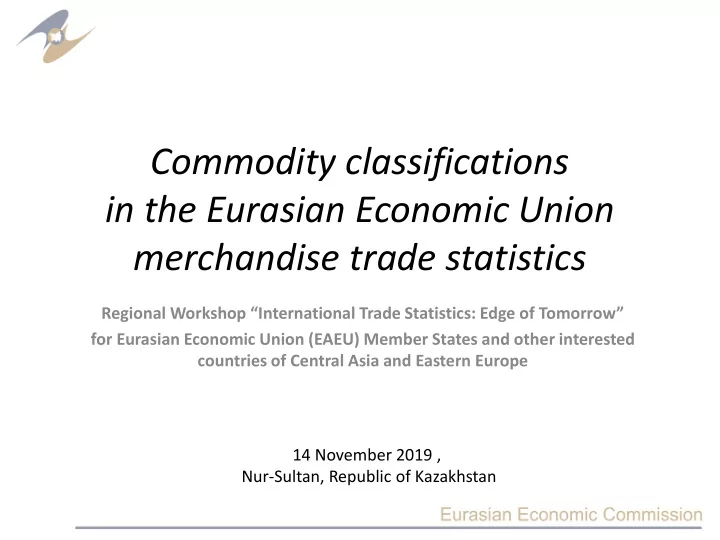

Commodity classifications in the Eurasian Economic Union merchandise trade statistics Regional Workshop “International Trade Statistics: Edge of Tomorrow” for Eurasian Economic Union (EAEU) Member States and other interested countries of Central Asia and Eastern Europe 14 November 2019 , Nur-Sultan, Republic of Kazakhstan
The EAEU Commodity Nomenclature of Foreign Economic Activity (EAEU CN FEA) Purpose of EAEU CN FEA: • customs clearance of export and import, • collection of customs duties (based on customs tariff), • foreign trade accounting in statistics. Lets think : • how efficiently analytical tasks are solved by EAEU CN FEA? • what else classifiers are there?
Standard International Trade Classification (SITC) • Created as a tool for conducting statistics on trade in goods (Revision 1, 1950). • In 1993 recognized by the UN Statistical Commission as an analytical tool. It can be used: • in the study of trends in international trade in goods, • most suitable for economic analysis.
Commodity classification by Broad Economic Categories (BEC) • Based on the converting of SITC into end-use categories, • within the meaning correspond to three classes of goods in the SNA : - capital goods, - intermediate goods, - consumer goods. It can be used: • in analytical tasks, • for international comparison of statistics on foreign trade.
Classification of Products by Activity (CPA) It can be used: • to study the relationship of products with economic activities, • in international comparisons, • cross-industry analysis, • tables resources, uses, input-output, • global value chain analysis.
Classification grouping by enlarged product groups – investment, intermediate, consumer (IIP) Grouping framework IPP (class, subclass) : • - investment - intermediate --- energy --- other intermediate - consumer --- food --- non-food It can be used: • - technological level of development of the country's economy, - analysis of the commodity structure of exports and imports, - food security potential, - global value chain analysis.
Correspondence keys table For each subheading on 10 signs of the EAEU CN FEA is assigned : • 2 digits numerical code – division code SITC (Rev. 4), • 19 basic categories BEC (Rev. 4), • 2 digits numerical code – division CPA (2008). • 3 digits numerical code – class/subclass (IIP).
Correspondence keys table preparation technique Correspondence keys Correspondence keys table EU table EAEU EAEU CN FEA code associate with EAEU CN FEA Combined (10 digits) Nomenclature Combined Nomenclature (8 digits) code - SITC - SITC - BEC - BEC - CPA - CPA
If the appropriate CN code was not found Correspondence keys Correspondence keys table EU table EAEU analysis product EAEU CN FEA Combined EAEU CN FEA description & (10 digits) Nomenclature (10 digits) code selection (8 digits) - SITC - SITC - BEC - BEC Combined Commodity Nomenclature - CPA - CPA code codes list (6 digits) (8 digits)
Correspondence keys table (IIP) The primary table of Research link: correspondence keys table was prepared for the EEC as part of the research by the Belarusian State Economic University
Use of correspondence keys in EEC SITC CPA IIP BEC
Use of trade statistics in EEC departments • Department for Trade Policy - analysis of the ratio of production volumes • Department for Industrial Policy - analysis of the market capacity of EAEU member states - assessment of production growth potential • Macroeconomic Policy Department - trading conditions analysis - tables resources, uses, input-output
Using correspondence keys • Economic analysis of merchandise trade, • comparison of foreign trade statistics with other branches of statistics, • regional and global comparisons, • integrated data generation.
Now you can apply the correspondence keys Thanks for your attention!
Recommend
More recommend